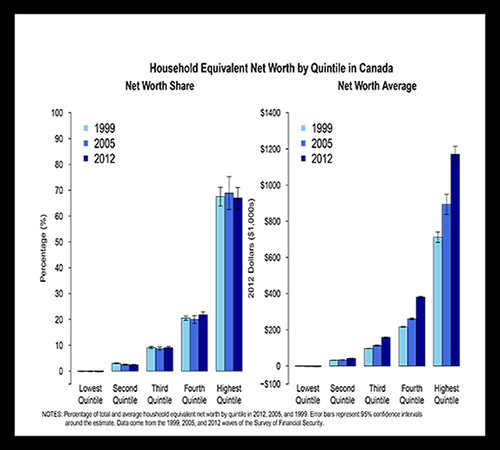Written by guest blogger, Michelle Maroto (@MarotoMichelle), author of “Fifteen Years of Wealth Disparities in Canada: New Trends or Simply the Status Quo?” featured in the Summer 2016 issue of Canadian Public Policy.
The issue is available to read here!
In assessing inequality in Canada, researchers tend to focus on income disparities and the labor market, but this often leaves out important resources, particularly those associated with wealth. Wealth, which incorporates household assets and debt, is an important factor for economic security. This is because wealth confers many advantages that include better neighborhoods, social and cultural capital, and added security in times of financial distress. Despite the importance of wealth in determining well being, research on wealth inequality across groups in Canada has been limited. To address this gap, my broader research project aims to create a better understanding of structural inequality related to assets, debt, and credit market access, with a particular focus on marginalized groups.
In a recent paper on this topic, I analyze disparities in household equivalent net worth and home ownership over the past 15 years using three waves of the Canadian Survey of Financial Security (1999, 2005, and 2012). Over this period, the wealthiest households in the top 20 percent of the population controlled about 67 percent of the total household equivalent net worth, while the poorest households in the bottom 20 percent controlled -0.1 percent of the total net worth. In addition, the average net worth for the top quintiles increased substantially between 1999 and 2012, but the bottom 60 percent of the distribution has seen little improvement in average wealth levels, as illustrated by the figure below. This shows that most of the wealth gains in Canada have gone to the wealthiest Canadians.
Beyond providing a basic discussion of wealth inequality in Canada, my study also highlights wealth disparities by Aboriginal identity, immigrant status, education, and disability status. What becomes obvious in these comparisons is that, even though aggregate wealth inequality has remained stable over this period, disparities have continued to grow for certain disadvantaged groups.
Certain families, particularly those with less education, those with persons with disabilities present, and those who immigrated to Canada, have seen growing inequality in net worth, even though group disparities in home ownership, a key component of wealth, have declined. Although data limitations did not permit comparisons over time, I find that Aboriginal households also experienced large homeownership disparities in 2012, which contributed to inequalities in net worth.
To further investigate some of the mechanisms behind these relationships I also break apart the direct and indirect effects of these variables on net worth in this paper. Doing so allows me to demonstrate how marginalized group membership leads to wealth disparities through its effects on homeownership and income, along with the more direct effects that remain after accounting for these factors. Thus, in addition to emphasizing wealth as a dimension of inequality, this paper also demonstrates how disadvantage can accumulate across areas of society, especially among adult immigrants, Aboriginal families, people with disabilities, and households with less education.
To learn more about wealth inequality in Canada, check out Dr. Maroto’s full article here!
Michelle Maroto is an Assistant Professor in the Sociology Department at the University of Alberta, which she joined in 2012 after receiving her PhD from the University of Washington. Her teaching and research interests center on social stratification and extend to areas of gender and family, race and ethnicity, criminology, economic sociology, labor and credit markets, and disability studies. Dr. Maroto’s recent projects have focused on the causes and consequences of bankruptcy, wealth disparities in the United States and Canada, the effects of incarceration on wealth, and labor market outcomes for people with different types of disabilities. These projects bring together her broader interests in processes of economic insecurity and cumulative disadvantage, both of which flow across areas and through households.

Comments on this entry are closed.